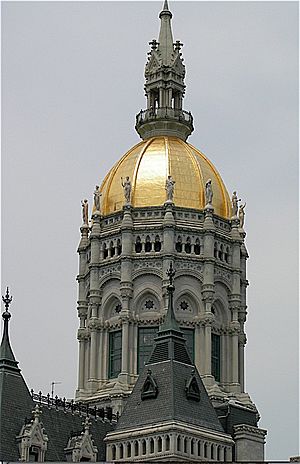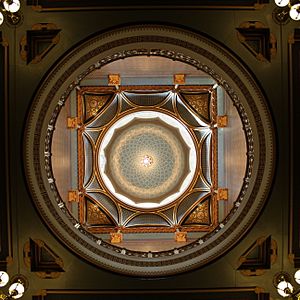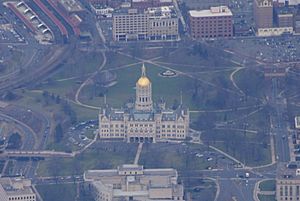Connecticut State Capitol facts for kids
|
Connecticut State Capitol
|
|
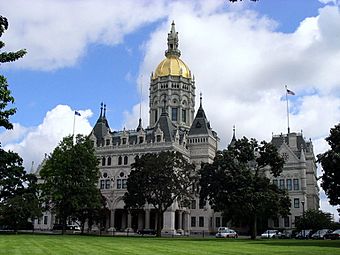
North facade of the Connecticut State Capitol, facing Bushnell Park.
|
|
| Location | Hartford, Connecticut |
|---|---|
| Built | 1872–1878 |
| Architect | Richard M. Upjohn, (1802–1878), with James G. Batterson, (1823–1901). |
| Architectural style | "Eastlake Movement" style, Victorian Gothic, Renaissance Revival |
| NRHP reference No. | 70000834 |
Quick facts for kids Significant dates |
|
| Added to NRHP | December 30, 1970 |
| Designated NHL | December 30, 1970 |
The Connecticut State Capitol is a very important building in Hartford, the capital city of Connecticut. It's located between Capitol Avenue and Bushnell Park. This building is where the state government works. It houses the Connecticut General Assembly, which is made up of two parts: the State Senate and the House of Representatives. The office of the Governor of Connecticut is also here. The Connecticut Supreme Court is in a separate building nearby.
History of the Capitol
The building you see today is the third capitol building for Connecticut since the American Revolution.
For a long time, the state's lawmaking group, the Connecticut General Assembly, met in two different cities: Hartford and New Haven. This made things complicated, especially after the American Civil War. Both cities wanted to be the only state capital. Hartford won the competition. This meant a new, central capitol building was needed.
The General Assembly decided to spend a million dollars on the project. Two people, James G. Batterson and Richard M. Upjohn, wanted to design it. Upjohn won the design job. However, Batterson, who sold stone, became the builder. Batterson kept changing Upjohn's plans. He made the building look more like his own ideas. For example, the tall central tower was Batterson's idea, not Upjohn's. All these changes made the building cost more than double the original price, over $2.5 million!
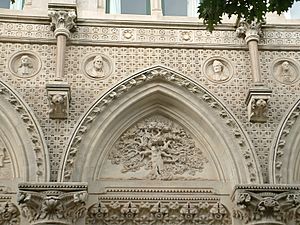
Richard M. Upjohn designed the Capitol in a style called Eastlake, with some French and Gothic Revival touches. Building started in 1871 and finished in 1878. The General Assembly began using it in January 1879. The New York Times newspaper said the new building looked like "a fairy palace of frost work."
The Capitol was built next to Bushnell Park. This spot was chosen because it had more open space than the old building downtown. This area used to be where Trinity College was located. It was known as "Trinity Hill."
Inside the Capitol, you can see historical items. Many are battle flags from Civil War units. About 10,000 veterans marched to the Capitol in 1879. They brought 30 regimental flags to be kept there. This made the building a special memorial to the Civil War.
Over the years, the building became crowded. Some changes were made that didn't fit the original design. But in the late 1970s and 1980s, efforts began to restore the Capitol.
In 1971, the State Capitol was named a National Historic Landmark. This means it's a very important historical place in the United States.
Capitol Architecture
The Connecticut State Capitol is one of the largest buildings in the Eastlake style. The outside is made of marble from East Canaan, Connecticut. It also uses granite from Westerly, Rhode Island. The building is shaped like a rectangle. Inside, there are two open courtyards that go all the way up to large skylights. In the center, there's a round open area called a rotunda, under the dome.
The outside of the building is very fancy. It has many statues, round decorations called medallions, and carved pictures above the doors. These statues show important politicians and people from Connecticut's history. Some of these include:
- Reverend Thomas Hooker
- Major John Mason
- Governor John Winthrop, Jr.
- Roger Sherman
- Revolutionary War Governor Jonathan Trumbull
- Noah Webster
- General Joseph Hawley
- Civil War Secretary of the Navy Gideon Welles
- United States Senator Orville Hitchcock Platt
There are 24 spots for statues, but eight of them are still empty. The newest statue added was of Ella T. Grasso. She was the first female governor of Connecticut.
Above most doors, there are carved scenes from the state's history. The carving above the main north door shows the state seal. The carving above the main east door is called The Charter Oak by Charles Salewski. This was the first sculpture made for the Capitol. The floors inside use white marble and red slate from Connecticut. Some colored marble came from Italy.
The statues and carvings are grouped by time period. The north side has figures from before the American Revolution. The east and west sides show people from the Revolutionary War or government service. The south side features people from the Civil War and later.
The central tower with its dome is very special. The dome itself is about 32 feet (9.8 meters) tall. On top of that is a smaller tower called a cupola, which is 55 feet (16.8 meters) high. The part below the dome, called the drum, is 75 feet (22.9 meters) tall. The main walls of the building are 70 feet (21.3 meters) high. The entire tower reaches a height of 257 feet (78.3 meters).
The building's dome once had a large statue on top called The Genius of Connecticut. It was taken down in 1938 because it was damaged in a big hurricane that year. The original statue was made of bronze. It was about 17.8 feet (5.4 meters) tall and weighed 7,000 pounds (3,175 kg). It was made in Rome and cast in Munich, Germany. During World War II, the statue was given to the government. It was melted down to make ammunition and machine parts for the war.
The original plaster model of the statue is now inside the Capitol. It has been covered in bronze. In 2009, a new bronze copy of the statue was made. It is waiting for more money to be placed back on top of the dome.
Around the base of the dome, there are 12 statues. They are in six pairs and represent things like Agriculture, Commerce, Education, Law, and Justice.
Inside, the Capitol has two beautiful open stairwells. The entire inside of the building is painted with many colors. This continues the 1870s Eastlake design style.
The Capitol Building is open to the public. You can take self-guided tours or guided tours on weekdays. Guided tours start inside the Legislative Office Building, which is next door.
|
Template:KIDDLE XL START
See also
 In Spanish: Capitolio del Estado de Connecticut para niños Template:KIDDLE XL END
In Spanish: Capitolio del Estado de Connecticut para niños Template:KIDDLE XL END




